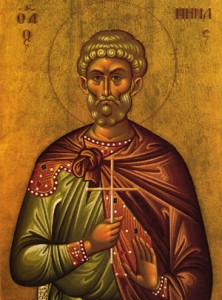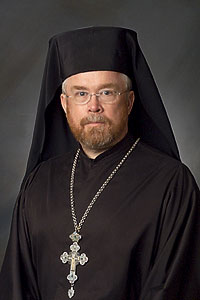
The holy and miracle-working icon of the Virgin Mary was brought to the Vatopedi monastery by the blessed elder Joseph from Nea Skete. The Monastery of Vatopedi is one of twenty monasteries on the Mount Athos peninsula (Greece) and is located on the northeastern side of the peninsula. It operates as a coenobitic monastery(a communal monastic community). As of 1999, it is inhabited by 80 monks and is second in hierarchical rank among the monasteries of the mountain.
The first record of the icon’s miraculous powers is from the witness of Elder Joseph. One day a young man from Cyprus went to visit and entered into the church. At that point, the elder witnessed a glowing light radiating from the face of the Theotokos and an invisible power pushed the young man down to the ground. When the young man had recovered from his fall, he began to repent and weep and confessed that he did not believe and was a participant in the black arts. He changed his life and became an Orthodox Christian.
This icon is also known for working many miracles, especially healing people with cancer. There are many recent records of people who have been healed from cancer after participating in the Supplicatory Canon to the Pantanassa at the monastery.
Text from http://russian-crafts.com/russian-saints-icons/pantanassa.html
The following text was translated and set to meter by Fr. Vasile Tudora. Some of the text (especially the heirmoi of each ode) is based on the translation of the Small Paraklesis to the Most Holy Theotokos from http://goarch.org/chapel/liturgical_texts/paraklesis. This has been done to ensure consistency with the current chanting practice in the Greek Orthodox Churches in America.
Pantanassa Paraklesis Booklet for parish usage
 Most probably the inventors of the internet, which modestly started as a small information sharing network, did not hope, even in their wildest dreams, that in less than 50 years their invention will evolve into what is today the greatest information exchange that ever existed. The library of Alexandria? Child play! Think about all that goes through the internet today: websites, e-mail, news, TV, social networks, entertainment, financials, do-it-yourself, phone calls, video calls, encyclopedias, e-books, maps and we’re just scratching the surface. All you want is there waiting to be found at the literal touch of a finger. Nobody asks anyone anything before they “google” the information.
Most probably the inventors of the internet, which modestly started as a small information sharing network, did not hope, even in their wildest dreams, that in less than 50 years their invention will evolve into what is today the greatest information exchange that ever existed. The library of Alexandria? Child play! Think about all that goes through the internet today: websites, e-mail, news, TV, social networks, entertainment, financials, do-it-yourself, phone calls, video calls, encyclopedias, e-books, maps and we’re just scratching the surface. All you want is there waiting to be found at the literal touch of a finger. Nobody asks anyone anything before they “google” the information. 



 Hamlet’s famous soliloquy, from William Shakespeare’s synonymous play, starting with the memorable phrase “To be or not to be, that is the question”, is a reflection that profoundly resonates with the Eastern Orthodox theology. Let me explain this.
Hamlet’s famous soliloquy, from William Shakespeare’s synonymous play, starting with the memorable phrase “To be or not to be, that is the question”, is a reflection that profoundly resonates with the Eastern Orthodox theology. Let me explain this.  I always liked this dialogue from the movie Pulp Fiction (slightly adapted for language):
I always liked this dialogue from the movie Pulp Fiction (slightly adapted for language):